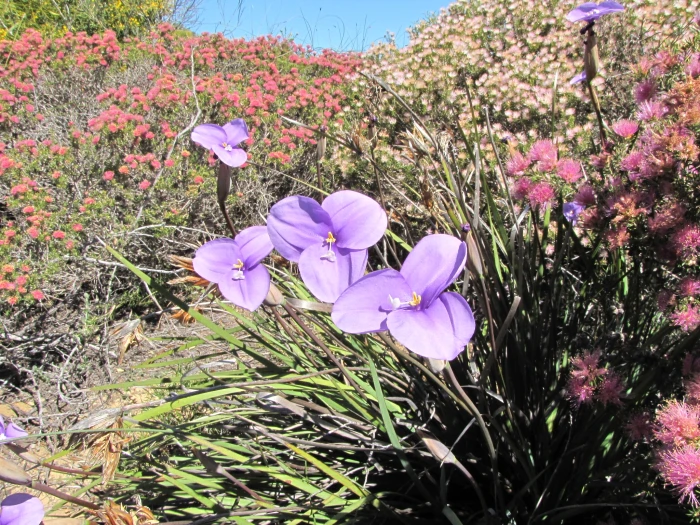Purple Flag
(Patersonia occidentalis)
Purple Flag (Patersonia occidentalis)
/
/

Gail A Baker
CC BY 4.0
Image By:
Gail A Baker
Recorded By:
Copyright:
CC BY 4.0
Copyright Notice:
Photo by: Gail A Baker | License Type: CC BY 4.0 | License URL: http://creativecommons.org/licenses/by/4.0/ | Rights Holder: Gail A Baker | Publisher: iNaturalist | Date Created: 2009-09-04T13:54:32-07:00 |




















Estimated Native Range
Climate Requirements for Santee, California
| This Plant | Your Site | Plant Suitability for Your Location | ||
|---|---|---|---|---|
| • Precipitation | 9" - 61" | 12" | Your precipitation may be insufficient for this plant. Irrigate N" / year. | Irrigate N" / year |
| • High Temp. | 61°F - 101°F | 89°F | Your summer temperatures are normal for this plant. | Excellent |
| • Low Temp. | 22°F - 50°F | 43°F | Your winter temperatures are normal for this plant | Excellent |
This plant should grow well at your location with about N inches per year (Y minutes per month) of irrigation.
Summary
Patersonia occidentalis, commonly known as Purple Flag or Long Purple-Flag, is a tufted, rhizome-forming perennial herb endemic to various habitats in southern Australia, including Western Australia, South Australia, Victoria, and Tasmania. It typically grows up to 4 feet 11 inches tall and features striking bluish-violet sepals that resemble petals. The plant produces a cylindrical capsule as its fruit. Purple Flag blooms from September to December, with each flower lasting just one day; however, the plant compensates by producing numerous flowers on each stem, creating a prolonged display of color. In its native environment, Patersonia occidentalis thrives in a range of habitats, from winter-wet areas and coastal sand dunes to granite outcrops, displaying a notable adaptability to different soil types and moisture levels.
Purple Flag is valued for its vibrant flowers and ability to bring color to the garden during its flowering season. It is frost-tolerant, making it suitable for cultivation in cooler regions. This plant is often used in borders, rockeries, and as a feature in native plant gardens due to its distinctive appearance and low maintenance requirements. It prefers full sun to part shade and requires well-drained soils. While it tolerates a range of soil types, it performs best in sandy soils that provide good drainage. Patersonia occidentalis is generally free from serious pests and diseases, but it can be susceptible to root rot in poorly drained conditions.CC BY-SA 4.0
Purple Flag is valued for its vibrant flowers and ability to bring color to the garden during its flowering season. It is frost-tolerant, making it suitable for cultivation in cooler regions. This plant is often used in borders, rockeries, and as a feature in native plant gardens due to its distinctive appearance and low maintenance requirements. It prefers full sun to part shade and requires well-drained soils. While it tolerates a range of soil types, it performs best in sandy soils that provide good drainage. Patersonia occidentalis is generally free from serious pests and diseases, but it can be susceptible to root rot in poorly drained conditions.CC BY-SA 4.0
Plant Description
- Plant Type: Herb
- Height: 1-2 feet
- Width: 1-2 feet
- Growth Rate: Slow
- Flower Color: Purple
- Flowering Season: Fall, Winter
- Leaf Retention: Evergreen
Growth Requirements
- Sun: Full Sun
- Water: Medium
- Drainage: Medium
Common Uses
Border Plant, Butterfly Garden, Groundcover, Low Maintenance, Rock Garden
Natural Habitat
Endemic to winter-wet areas, coastal sand dunes, and granite outcrops in southern Australia
Other Names
Common Names: Purple Flag, Native Iris
Scientific Names: Patersonia occidentalis, Genosiris occidentalis
GBIF Accepted Name: Patersonia occidentalis